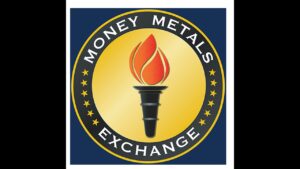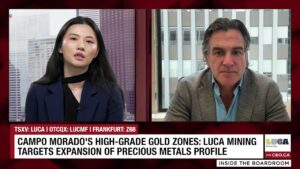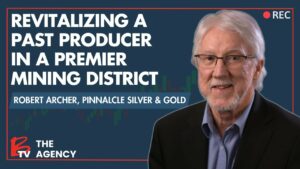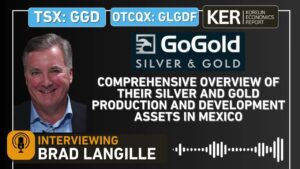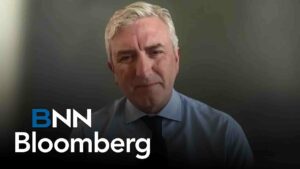Rampant debt, credit deflation and impotent monetary policies are fueling a bull market for gold and gold equities according to Jay Taylor, editor and publisher of J. Taylor’s Gold, Energy & Tech Stocks. His Progress A1 companies were up a combined 22% as of Oct. 17. Taylor shares those names and some lesser-known stories in this Gold Report interview.
The Gold Report: Jay, what investment themes are you focusing on in your newsletter?
Jay Taylor: I focus a lot on the huge credit deflation that the markets are demanding. Debt has become so large that it cannot be serviced with the amount of income available. The so-called solution requires the creation of more debt money. In a fiat currency system, money is debt.
At some point, total debt levels have to be wound down to levels akin to the normal levels of the past when total debt to GDP in the U.S. ranged between 175% and 225%. Following Lehman Brothers it grew to over 360%! These debt levels simply cannot be repaid from current income steams even with zero interest rates. Those debt levels are leading to tension in the banking system that bodes very well for gold because people are starting to lose confidence in the banking system and in the fiat monetary system itself. As long as credit deflation remains intact, it will be a very bullish environment for gold and gold mining stocks.
Another major focus is what I call the “real” price of gold. Is gold going up relative to most other things? Or, putting it another way, what will an ounce of gold buy? I like to measure gold’s purchasing power in terms of the Rogers Raw Materials Fund, which includes energy, base metals, food and clothing related commodities like cotton and wool. Indeed, the real price of gold has risen dramatically from 17% in July 2008 just before the Lehman Brothers failure to something like 44% of the fund by March 2009 (See chart below); it has risen to 49.5% at the height of the European crisis a few months back.
![Taylor purchpow Taylor purchpow]()
From 17% pre-Lehman Brothers in July 2008 to 47% at the end of October, the trend of gold’s purchasing power in terms of how much of the Rogers Raw Materials Fund it will buy is in a clear and dramatic Uptrend. Not surprisingly then, the profits of major gold producers has risen as demonstrated in the chart above.
It is not a coincidence that gold mining profits of the big household names in the gold space rose along with the real gold price.
To keep track of how the big gold mining firms are doing, I follow the earnings of seven majors. If you add up the per-share profits, their consolidated per-share profits went from $8.30 in 2008 to $20.50 in 2011. The consensus analyst estimates for 2012 are down a bit to $19.75 in 2012. For 2013, the latest prediction of the collective profits for these seven companies are $24almost triple where they were in 2008 on the eve of this major ongoing credit deleveraging crisis.
TGR: Which miners comprise that list, Jay?
JT: The seven are Newmont Mining Corp. (NEM:NYSE), Goldcorp Inc. (G:TSX; GG:NYSE), Agnico-Eagle Mines Ltd. (AEM:TSX; AEM:NYSE), AngloGold Ashanti Ltd. (AU:NYSE; ANG:JSE; AGG:ASX; AGD:LSE), Barrick Gold Corp. (ABX:TSX; ABX:NYSE), Kinross Gold Corp. (K:TSX; KGC:NYSE) and Yamana Gold Inc. (YRI:TSX; AUY:NYSE; YAU:LSE). (See chart below).
![Taylor seven majors Taylor seven majors]()
I picked those seven because they are large companies, they are in production and they had operating performance before the financial crisis began with the Lehman Brothers failure.
TGR: Their per-share profits may have tripled, but their share prices have not performed anywhere near that well. One reason for that performance gap is cost increases. Are there other reasons?
JT: Capital expenses (capex) have increased a great deal from the post-2008 recovery. Many of the big companies are plowing huge amounts of money back into the ground, and sustaining capex is rising, so they are expending a considerable amount of cash to expand or just to keep producing large amounts of gold.
But at least since Lehman Brothers, day to day operating costs have declined. As a result, the cash flow from operations has risen dramatically.
The other reason share prices have not risen is most of the market believes that $1,700/ounce (oz) gold is near its peak. In short, unlike me and others who follow Austrian economic theory, most investors do not understand that gold is money and that as long as the credit market problems persist, it will become increasingly valuable. Americans especially are ignorant about gold. They are much more likely to buy Facebook or Google; they do not even consider buying gold shares. At some point, these people will wake up to the reality that the gold mining companies, not the Federal Reserve, have the power to produce moneyat least money people can trust.
TGR: Your Inflation-Deflation Watch (IDW) index measures major commodities and equity and bond indexes. It suggests that we are on the verge of an inflationary breakout. Has the IDW consistently tracked previous breakouts in the gold price?
JT: I started the IDW in January 2005, so it does not have a long history. We had a brief period of deflation from the index’s starting point of 100 to around 94, following the Lehman Brothers collapse, and then it started to rise. Last year, it hit new highs. Now, with each successive quantitative easing (QE), the IDW is having a hard time making new highs. We are seeing lower highs and lower lows. (See chart below).
![Taylor IDW Taylor IDW]()
Now, I am not sure which way the IDW is going to break out. We have a pennant formation here: If you draw a line through the top points of the IDW and a line through the bottom points of the IDW, you will see that a moment of truth is quickly approaching. It may not be decisively up or down; it may meander for a while. But we may be perched on a knife’s edge, in which we may now be facing a moment of truth in how our current economic pathology plays out. We could be on the verge of either a hyperinflationary depression or a deflationary depression, which Bob Prechter, Ian Gordon and others believe will make the 1930s period look like child’s play.
What I do think is undeniable is that QE is increasingly impotent. I personally believe we are most likely headed toward a deflationary depression. Unless the Fed and other central bankers completely obliterate the capitalist system and turn to a statist system, and distribute trillions of dollars to lower income and middle income people, I do not see us getting to hyperinflation.
TGR: An inflationary breakout could be good for the gold price, but possibly bad for mining equities if costs rise faster than the price of gold.
JT: I absolutely agree. In a hyperinflationary scenario it becomes very difficult to like gold mining stocks or any kind of business activity because it is so difficult to plan. In that environment, you want to own physical gold and silver, ideally free and clear of debt.
TGR: Your top-tier gold producers, or what you call your Progress A1 companies, were up a combined 22% as of Oct. 17. Which do you expect to be steady performers in an environment of high gold prices?
JT: Sandstorm Gold Ltd. (SSL:TSX.V) has been my No. 1 pick all year, and would stay No. 1 especially in a more inflationary environment.
That is because Sandstorm enters into agreements with start-up mining companies whereby it can buy gold at the cost of production for the life of a mine in exchange for providing startup capital required to get into production. Assume that gold went to $5,000/oz, and the cost of production goes up to $4,900/oz. That would squeeze the producers’ margins. But Sandstorm would still be buying some agreed to percentage of life of mine production at, say, $400/oz, which is more or less its current cost of gold purchase. That provides Sandstorm a gigantic profit margin even at current gold prices of around $1,6001,700/oz. Not only that, Sandstorm does not have to invest more for sustaining capital through the life of a mine as the operating company must do. As per its agreement, after it supplies startup capital, Sandstorm doesn’t have to spend any more money to keep buying gold at the cost of production, usually based on feasibility studies when the project went into production. A typical arrangement would have Sandstorm being able to buy between 10% and 25% of a project’s gold production at cost.
Another favorite is Dynacor Gold Mines Inc. (DNG:TSX). It will produce around 50,000 oz (50 Koz) this year. Basically, it is a gold refiner. It buys gold ore from licensed producers in Peru and makes a couple hundred or so dollars an ounce. It assays the gold from shipments and then pays the miner on the spot for the gold contained in the ore after building in a spread for its recovery services.
TGR: Rather like a toll road.
JT: Exactly. It is a toll operator, but one that can pick and choose, and it chooses very high-grade gold ore. I believe the average grades it has run through its mill has been around 0.9 ounces per ton in the latest reporting period. Dynacor could well double its production over the next two to three years. It also owns an 800 Koz non-NI-43-101-compliant deposit.
TGR: Is that Tumipampa?
JT: Yes. Tumipampa is in the middle of some of the world’s biggest gold and copper skarn porphyry deposits. Dynacor will explore and develop that on its own. If it turns out to be as big as management expects it may be, Dynacor will look for a major gold or copper joint venture partner to advance the Tumipampa project into production.
In addition, some of Dynacor’s competitors were recently de-licensed by the Peruvian government for using mercury-based processes in recovering gold. That played to Dynacor’s favor because its environmental compliance is fully up to snuff.
Jean Martineau, the company’s CEO, is a Canadian who has spent many years in Peru. He built Dynacor slowly, depending on internal growth. Because of him, Dynacor enjoys a great relationship with the small miners in Peru.
TGR: Do you have another name from the A1 group?
JT: Eurasian Minerals Inc. (EMX:TSX.V) made it into the A1 group based on $6.2 million (M) in cash flow it expects next year from a royalty interest expected to grow dramatically over a number of years on a large mine in Nevada operated by Newmont. Eurasian is a project generator with lots of working capital; lots of projects in Australia, Turkey, Haiti and the U.S.; and, now, cash flow. This company has a lot of cash on its balance sheet and major companies spending major dollars to find world class deposits. If just one hitsI think there will be more than one success over timethis stock will be a big winner.
I would also mention OceanaGold Corp. (OGC:TSX; OGC:ASX), which is about to start production on a copper-gold operation called Didipio in the Philippines. The copper production will help offset the high cost of gold production in New Zealand.
TGR: Where will its growth come from?
JT: Mostly from the Philippines. The startup is fairly modest. Initially plans were to produce on a much larger scale but then scaled back production plans so capital costs would be much more modest. But this is a very large gold-copper deposit that should lead to significant growth for years to come. OceanaGold also has some growth potential in New Zealand, mostly high-grade, underground material with fairly high costs. I own this company because of its Philippine prospects.
TGR: In September you predicted that many of the “names in this letter will likely vanish” if asset prices take another massive plunge. Which companies have enough cash to last two or even three years?
JT: Most of the A1 companies are in pretty good shape and have cash flow from production that will keep them alive. Aurizon Mines Ltd. (ARZ:TSX; AZK:NYSE.MKT), for example, has more than $200M in working capital and lots of growth prospects in Québec.
Alexco Resource Corp. (AXR:TSX; AXU:NYSE.MKT), a silver producer in the Yukon, has only $32M in working capital, but lots of exploration potential and new projects coming on stream in the next couple of years. It will be able to grow those largely from internal cash flow.
And while Petaquilla Minerals Ltd. (PTQ:TSX; PTQMF:OTCBB; P7Z:FSE) has a lot of debt, it also has good, strong cash flow.
I think investors should focus on the A1 companies, especially investors with a lower-risk tolerance. Choose the companies with advanced projects and cash flow that can grow organically without having to go back to the markets.
I am interested in companies that are growing and have good businesses, whether or not the share prices reflect that. Ultimately the share prices should catch up.
TGR: With $200M in working capital, will Aurizon launch a dividend?
JT: If Aurizon put out a small dividend because its peers are doing it, that might make its share price more attractive. These days, it does not take much of a yield to make people happy.
But Aurizon is earning into eight or so projects being developed by juniors in Québec. If any of them become significant mining projects in their own right, Aurizon will need a lot of capital to develop them.
TGR: Alexco operates the Bellekeno silver mine in the Yukon, which saw a 12% increase in silver production in Q3/12. Where will Alexco’s growth come from?
JT: It has a number of projects on the drawing board, including three in the feasibility stage and several more where it is developing a resource. It has a host of earlier-stage projects as well. For me, Alexco is one of the more attractive silver plays and its location in the Yukon makes it politically safe. It seems to have almost endless growth potential.
TGR: Petaquilla Minerals seems like an event-driven story. It has an ongoing issue with Inmet Mining Corp. (IMN:TSX). Could you explain that situation?
JT: To develop its business, Inmet needs the project that Petaquilla has going in Panama. Inmet’s efforts to influence the Panama government to get Petaquilla out of its way have not worked so far.
Petaquilla is producing nice cash flow from its operation in Panama. It also has very good-looking projects in Spain and Portugal.
Eventually, I believe Inmet will have to buy Petaquilla out. Inmet made an offer that Petaquilla found insufficient. A game of chicken may be going on now.
TGR: Inmet just got close to $1 billion (B) from Franco-Nevada Corp. (FNV:TSX; FNV:NYSE) to develop its projects in Panama. Could Inmet use some of that money to sweeten a bid for Petaquilla?
JT: For sure. Petaquilla’s market cap is not that big. For Inmet, a relatively small sweetener would do. It is similar to giving your kids an increase in their allowance.
TGR: Can you share some newer names that excite you, but may not be familiar to people who are not regular readers of your newsletter?
JT: The first is a uranium play. Blue Sky Uranium Corp. (BSK:TSX.V) has a project in Argentina. It has only 23M shares outstanding, and sells at about $0.085 or so. It has a large tract of land where AREVA (AREVA:EPA) will spend several million dollars to earn 70% interest in the project.
As I understand it, AREVA has selected this as one of its three top prospects for a major uranium discovery. It is very near-surface, even at-surface in places, a flat-lying, low-grade, massive target. Trenching results should be out soon and sampling work in the past leads me to believe there is a high probability of success on this project. The company is just starting to tell its story.
Blue Sky’s market cap is maybe $2M. I bought it for my retirement account. I got a lot of shares for very little cost because it is so inexpensive. So that’s a speculative story that I think is worth watching.
Another company that is very exciting is Bravada Gold Corp. (BVA:TSX.V). I like the project generator modelfocusing only on early exploration and not spending on costly drilling. Bravada is mainly following that model in Nevada. It has a project that is called the Wind Mountain project. It just recently signed a deal with Argonaut Gold Inc. (AR:TSX). Argonaut has to spend $7.5M on the project to earn an option to buy gold equivalent resource there, paying $30/oz for that resource and leaving a 1% net smelter royalty for Bravada.
Bravada has a market cap of about $7.5M. The project already has just under 1 million ounce (Moz) gold equivalent resource at this time (all categories). I think those numbers will go up considerably with $7.5M spent on drilling. Some of that will go to upgrading, but a lot of it will be stepout drilling. Wind Mountain is a former gold producer. It has lots of other projects that other companies are spending money to go in to develop. Bravada’s stock is at $0.055 cents right now and is very undervalued. It’s very small, but it has good management and does have other projects in Nevada that money will be spent on by other partners. I don’t think people are paying attention. Argonaut is a proven, smaller midtier producer that could make it happen.
I also like Aurvista Gold Corp. (AVA:TSX.V) in Québec. It has an open-pittable resource, just under 3 Moz, with lots of exploration potential.
This is the kind of company Aurizon is likely at some point to take a run at. Norvista Resources Corp., a private merchant bank in Toronto, already has an interest in Aurvista.
Norvista is also involved with Solvista Gold Corp. (SVV:TSX.V; SVVZF:OTCQX). It had some interesting intercepts in Colombia, one is 149 meters (m) at 2.1 grams per ton (g/t) gold and another is 185m of 1.68 g/t gold. However, these are vertical deposits, so it is unclear how much can be mined economically. But again, Solvista has deep pockets behind it.
Urastar Gold Corp. (URS:TSX.V; URNRF:OTCQX) has the La Juliana gold project in Mexico. It is small but very strategically located in the middle of Alamos Gold Inc.’s (AGI:TSX) Mulatos operation. Agnico-Eagle is there too. Urastar’s project will probably have to be taken out. If it is, Urastar can use the money to keep developing El Antimonio, its primary target in the region.
TGR: Urastar is led by Adrian Robertson and Bill Reed.
JT: Both have very good records, Robertson from a technical point of view and Reed as an exploration geologist.
TGR: How does a company get a property smack dab in the middle of what Alamos and Agnico-Eagle have?
JT: I suppose Urastar picked up the projects when no one was interested in those targets. Often, little companies form relationships with people; they get to know people more intimately than the majors. But I’m honestly not sure of the history of this acquisition.
TGR: Any other companies you would like to mention?
JT: Northern Freegold Resources Ltd. (NFR:TSX.V; NFRGF:OTCQX) in the Yukon has just under 6 Moz gold equivalent, with copper and molybdenum in the deposit as well. Northern Freegold’s infrastructure situation is much better than most. It has direct access to the property and a power line can be extended at a cost of $10M or so. That is a low capex number relative to a 6 Moz gold deposit. The economics have yet to be established, but it looks very promising.
TGR: Do you have any insights to leave our readers with today?
JT: Lots of money is to be made in the right kind of gold mining companies. I am much more bullish on gold than other commodities, in large part because I do not see good, solid economic growth around the world. I would like to think you could make money producing other minerals that would help people more than producing gold that will just sit in vaults. But that is the reality.
The markets are forcing us to acknowledge the truth that gold is real money. The markets and the truth are rearing their beautiful heads. That is the real positive news.
TGR: Thank you very much, Jay.
As he followed the demolition of the U.S. gold standard and the rapid rise in the national debt, Jay Taylor’s interest in U.S. monetary and fiscal policy grew, particularly as it related to gold. He began publishing North American Gold Mining Stocks in 1981. In 1997, he decided to pursue his avocation as a new full-time careerincluding publication of his weekly J. Taylor’s Gold, Energy & Tech Stocks newsletter. He also has a radio program, “Turning Hard Times Into Good Times.”
DISCLOSURE:
1) Brian Sylvester of The Gold Report conducted this interview. He personally and/or his family own shares of the following companies mentioned in this interview: None.
2) The following companies mentioned in the interview are sponsors of The Gold Report: Goldcorp. Inc., Aurizon Mines Ltd., Petaquilla Minerals Ltd., Franco-Nevada Corp., Argonaut Gold Inc., Aurvista Gold Corp., Solvista Gold Corp., Urastar Gold Corp. and Northern Freegold Resources Ltd. Streetwise Reports does not accept stock in exchange for services. Interviews are edited for clarity.
3) Jay Taylor: I personally and/or my family own shares of the following companies mentioned in this interview: Sandstorm Gold Ltd., Dynacor Gold Mines Inc., Eurasian Minerals Inc., Alexco Resource Corp., Petaquilla Minerals Ltd., Blue Sky Uranium Corp., Bravada Gold Corp., Aurvista Gold Corp. and Northern Freegold Resources Ltd. I write solely for my paid subscribers. After the fact, companies sometimes purchase the right to reprint articles written for my subscribers. As host to the web radio show, “Turning Hard Times into Good Times,” the following companies have been or currently are sponsors to the show: Dynacor Gold Mines Inc., Eurasian Minerals Inc., Blue Sky Uranium Corp., Bravada Gold Corp., Aurvista Gold Corp. and Northern Freegold Resources Ltd. I was not paid by Streetwise Reports for participating in this interview.
The Gold Report: Jay, what investment themes are you focusing on in your newsletter?
Jay Taylor: I focus a lot on the huge credit deflation that the markets are demanding. Debt has become so large that it cannot be serviced with the amount of income available. The so-called solution requires the creation of more debt money. In a fiat currency system, money is debt.
At some point, total debt levels have to be wound down to levels akin to the normal levels of the past when total debt to GDP in the U.S. ranged between 175% and 225%. Following Lehman Brothers it grew to over 360%! These debt levels simply cannot be repaid from current income steams even with zero interest rates. Those debt levels are leading to tension in the banking system that bodes very well for gold because people are starting to lose confidence in the banking system and in the fiat monetary system itself. As long as credit deflation remains intact, it will be a very bullish environment for gold and gold mining stocks.
Another major focus is what I call the “real” price of gold. Is gold going up relative to most other things? Or, putting it another way, what will an ounce of gold buy? I like to measure gold’s purchasing power in terms of the Rogers Raw Materials Fund, which includes energy, base metals, food and clothing related commodities like cotton and wool. Indeed, the real price of gold has risen dramatically from 17% in July 2008 just before the Lehman Brothers failure to something like 44% of the fund by March 2009 (See chart below); it has risen to 49.5% at the height of the European crisis a few months back.

Taylor purchpow
From 17% pre-Lehman Brothers in July 2008 to 47% at the end of October, the trend of gold’s purchasing power in terms of how much of the Rogers Raw Materials Fund it will buy is in a clear and dramatic Uptrend. Not surprisingly then, the profits of major gold producers has risen as demonstrated in the chart above.
It is not a coincidence that gold mining profits of the big household names in the gold space rose along with the real gold price.
To keep track of how the big gold mining firms are doing, I follow the earnings of seven majors. If you add up the per-share profits, their consolidated per-share profits went from $8.30 in 2008 to $20.50 in 2011. The consensus analyst estimates for 2012 are down a bit to $19.75 in 2012. For 2013, the latest prediction of the collective profits for these seven companies are $24almost triple where they were in 2008 on the eve of this major ongoing credit deleveraging crisis.
TGR: Which miners comprise that list, Jay?
JT: The seven are Newmont Mining Corp. (NEM:NYSE), Goldcorp Inc. (G:TSX; GG:NYSE), Agnico-Eagle Mines Ltd. (AEM:TSX; AEM:NYSE), AngloGold Ashanti Ltd. (AU:NYSE; ANG:JSE; AGG:ASX; AGD:LSE), Barrick Gold Corp. (ABX:TSX; ABX:NYSE), Kinross Gold Corp. (K:TSX; KGC:NYSE) and Yamana Gold Inc. (YRI:TSX; AUY:NYSE; YAU:LSE). (See chart below).
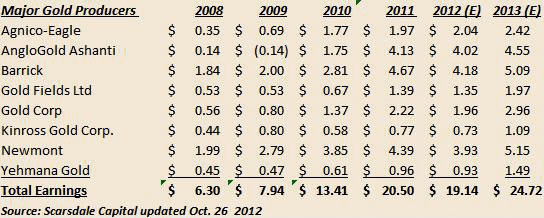
Taylor seven majors
I picked those seven because they are large companies, they are in production and they had operating performance before the financial crisis began with the Lehman Brothers failure.
TGR: Their per-share profits may have tripled, but their share prices have not performed anywhere near that well. One reason for that performance gap is cost increases. Are there other reasons?
JT: Capital expenses (capex) have increased a great deal from the post-2008 recovery. Many of the big companies are plowing huge amounts of money back into the ground, and sustaining capex is rising, so they are expending a considerable amount of cash to expand or just to keep producing large amounts of gold.
But at least since Lehman Brothers, day to day operating costs have declined. As a result, the cash flow from operations has risen dramatically.
The other reason share prices have not risen is most of the market believes that $1,700/ounce (oz) gold is near its peak. In short, unlike me and others who follow Austrian economic theory, most investors do not understand that gold is money and that as long as the credit market problems persist, it will become increasingly valuable. Americans especially are ignorant about gold. They are much more likely to buy Facebook or Google; they do not even consider buying gold shares. At some point, these people will wake up to the reality that the gold mining companies, not the Federal Reserve, have the power to produce moneyat least money people can trust.
TGR: Your Inflation-Deflation Watch (IDW) index measures major commodities and equity and bond indexes. It suggests that we are on the verge of an inflationary breakout. Has the IDW consistently tracked previous breakouts in the gold price?
JT: I started the IDW in January 2005, so it does not have a long history. We had a brief period of deflation from the index’s starting point of 100 to around 94, following the Lehman Brothers collapse, and then it started to rise. Last year, it hit new highs. Now, with each successive quantitative easing (QE), the IDW is having a hard time making new highs. We are seeing lower highs and lower lows. (See chart below).
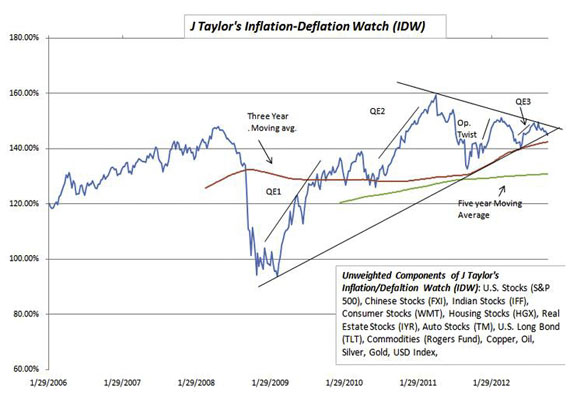
Taylor IDW
Now, I am not sure which way the IDW is going to break out. We have a pennant formation here: If you draw a line through the top points of the IDW and a line through the bottom points of the IDW, you will see that a moment of truth is quickly approaching. It may not be decisively up or down; it may meander for a while. But we may be perched on a knife’s edge, in which we may now be facing a moment of truth in how our current economic pathology plays out. We could be on the verge of either a hyperinflationary depression or a deflationary depression, which Bob Prechter, Ian Gordon and others believe will make the 1930s period look like child’s play.
What I do think is undeniable is that QE is increasingly impotent. I personally believe we are most likely headed toward a deflationary depression. Unless the Fed and other central bankers completely obliterate the capitalist system and turn to a statist system, and distribute trillions of dollars to lower income and middle income people, I do not see us getting to hyperinflation.
TGR: An inflationary breakout could be good for the gold price, but possibly bad for mining equities if costs rise faster than the price of gold.
JT: I absolutely agree. In a hyperinflationary scenario it becomes very difficult to like gold mining stocks or any kind of business activity because it is so difficult to plan. In that environment, you want to own physical gold and silver, ideally free and clear of debt.
TGR: Your top-tier gold producers, or what you call your Progress A1 companies, were up a combined 22% as of Oct. 17. Which do you expect to be steady performers in an environment of high gold prices?
JT: Sandstorm Gold Ltd. (SSL:TSX.V) has been my No. 1 pick all year, and would stay No. 1 especially in a more inflationary environment.
That is because Sandstorm enters into agreements with start-up mining companies whereby it can buy gold at the cost of production for the life of a mine in exchange for providing startup capital required to get into production. Assume that gold went to $5,000/oz, and the cost of production goes up to $4,900/oz. That would squeeze the producers’ margins. But Sandstorm would still be buying some agreed to percentage of life of mine production at, say, $400/oz, which is more or less its current cost of gold purchase. That provides Sandstorm a gigantic profit margin even at current gold prices of around $1,6001,700/oz. Not only that, Sandstorm does not have to invest more for sustaining capital through the life of a mine as the operating company must do. As per its agreement, after it supplies startup capital, Sandstorm doesn’t have to spend any more money to keep buying gold at the cost of production, usually based on feasibility studies when the project went into production. A typical arrangement would have Sandstorm being able to buy between 10% and 25% of a project’s gold production at cost.
Another favorite is Dynacor Gold Mines Inc. (DNG:TSX). It will produce around 50,000 oz (50 Koz) this year. Basically, it is a gold refiner. It buys gold ore from licensed producers in Peru and makes a couple hundred or so dollars an ounce. It assays the gold from shipments and then pays the miner on the spot for the gold contained in the ore after building in a spread for its recovery services.
TGR: Rather like a toll road.
JT: Exactly. It is a toll operator, but one that can pick and choose, and it chooses very high-grade gold ore. I believe the average grades it has run through its mill has been around 0.9 ounces per ton in the latest reporting period. Dynacor could well double its production over the next two to three years. It also owns an 800 Koz non-NI-43-101-compliant deposit.
TGR: Is that Tumipampa?
JT: Yes. Tumipampa is in the middle of some of the world’s biggest gold and copper skarn porphyry deposits. Dynacor will explore and develop that on its own. If it turns out to be as big as management expects it may be, Dynacor will look for a major gold or copper joint venture partner to advance the Tumipampa project into production.
In addition, some of Dynacor’s competitors were recently de-licensed by the Peruvian government for using mercury-based processes in recovering gold. That played to Dynacor’s favor because its environmental compliance is fully up to snuff.
Jean Martineau, the company’s CEO, is a Canadian who has spent many years in Peru. He built Dynacor slowly, depending on internal growth. Because of him, Dynacor enjoys a great relationship with the small miners in Peru.
TGR: Do you have another name from the A1 group?
JT: Eurasian Minerals Inc. (EMX:TSX.V) made it into the A1 group based on $6.2 million (M) in cash flow it expects next year from a royalty interest expected to grow dramatically over a number of years on a large mine in Nevada operated by Newmont. Eurasian is a project generator with lots of working capital; lots of projects in Australia, Turkey, Haiti and the U.S.; and, now, cash flow. This company has a lot of cash on its balance sheet and major companies spending major dollars to find world class deposits. If just one hitsI think there will be more than one success over timethis stock will be a big winner.
I would also mention OceanaGold Corp. (OGC:TSX; OGC:ASX), which is about to start production on a copper-gold operation called Didipio in the Philippines. The copper production will help offset the high cost of gold production in New Zealand.
TGR: Where will its growth come from?
JT: Mostly from the Philippines. The startup is fairly modest. Initially plans were to produce on a much larger scale but then scaled back production plans so capital costs would be much more modest. But this is a very large gold-copper deposit that should lead to significant growth for years to come. OceanaGold also has some growth potential in New Zealand, mostly high-grade, underground material with fairly high costs. I own this company because of its Philippine prospects.
TGR: In September you predicted that many of the “names in this letter will likely vanish” if asset prices take another massive plunge. Which companies have enough cash to last two or even three years?
JT: Most of the A1 companies are in pretty good shape and have cash flow from production that will keep them alive. Aurizon Mines Ltd. (ARZ:TSX; AZK:NYSE.MKT), for example, has more than $200M in working capital and lots of growth prospects in Québec.
Alexco Resource Corp. (AXR:TSX; AXU:NYSE.MKT), a silver producer in the Yukon, has only $32M in working capital, but lots of exploration potential and new projects coming on stream in the next couple of years. It will be able to grow those largely from internal cash flow.
And while Petaquilla Minerals Ltd. (PTQ:TSX; PTQMF:OTCBB; P7Z:FSE) has a lot of debt, it also has good, strong cash flow.
I think investors should focus on the A1 companies, especially investors with a lower-risk tolerance. Choose the companies with advanced projects and cash flow that can grow organically without having to go back to the markets.
I am interested in companies that are growing and have good businesses, whether or not the share prices reflect that. Ultimately the share prices should catch up.
TGR: With $200M in working capital, will Aurizon launch a dividend?
JT: If Aurizon put out a small dividend because its peers are doing it, that might make its share price more attractive. These days, it does not take much of a yield to make people happy.
But Aurizon is earning into eight or so projects being developed by juniors in Québec. If any of them become significant mining projects in their own right, Aurizon will need a lot of capital to develop them.
TGR: Alexco operates the Bellekeno silver mine in the Yukon, which saw a 12% increase in silver production in Q3/12. Where will Alexco’s growth come from?
JT: It has a number of projects on the drawing board, including three in the feasibility stage and several more where it is developing a resource. It has a host of earlier-stage projects as well. For me, Alexco is one of the more attractive silver plays and its location in the Yukon makes it politically safe. It seems to have almost endless growth potential.
TGR: Petaquilla Minerals seems like an event-driven story. It has an ongoing issue with Inmet Mining Corp. (IMN:TSX). Could you explain that situation?
JT: To develop its business, Inmet needs the project that Petaquilla has going in Panama. Inmet’s efforts to influence the Panama government to get Petaquilla out of its way have not worked so far.
Petaquilla is producing nice cash flow from its operation in Panama. It also has very good-looking projects in Spain and Portugal.
Eventually, I believe Inmet will have to buy Petaquilla out. Inmet made an offer that Petaquilla found insufficient. A game of chicken may be going on now.
TGR: Inmet just got close to $1 billion (B) from Franco-Nevada Corp. (FNV:TSX; FNV:NYSE) to develop its projects in Panama. Could Inmet use some of that money to sweeten a bid for Petaquilla?
JT: For sure. Petaquilla’s market cap is not that big. For Inmet, a relatively small sweetener would do. It is similar to giving your kids an increase in their allowance.
TGR: Can you share some newer names that excite you, but may not be familiar to people who are not regular readers of your newsletter?
JT: The first is a uranium play. Blue Sky Uranium Corp. (BSK:TSX.V) has a project in Argentina. It has only 23M shares outstanding, and sells at about $0.085 or so. It has a large tract of land where AREVA (AREVA:EPA) will spend several million dollars to earn 70% interest in the project.
As I understand it, AREVA has selected this as one of its three top prospects for a major uranium discovery. It is very near-surface, even at-surface in places, a flat-lying, low-grade, massive target. Trenching results should be out soon and sampling work in the past leads me to believe there is a high probability of success on this project. The company is just starting to tell its story.
Blue Sky’s market cap is maybe $2M. I bought it for my retirement account. I got a lot of shares for very little cost because it is so inexpensive. So that’s a speculative story that I think is worth watching.
Another company that is very exciting is Bravada Gold Corp. (BVA:TSX.V). I like the project generator modelfocusing only on early exploration and not spending on costly drilling. Bravada is mainly following that model in Nevada. It has a project that is called the Wind Mountain project. It just recently signed a deal with Argonaut Gold Inc. (AR:TSX). Argonaut has to spend $7.5M on the project to earn an option to buy gold equivalent resource there, paying $30/oz for that resource and leaving a 1% net smelter royalty for Bravada.
Bravada has a market cap of about $7.5M. The project already has just under 1 million ounce (Moz) gold equivalent resource at this time (all categories). I think those numbers will go up considerably with $7.5M spent on drilling. Some of that will go to upgrading, but a lot of it will be stepout drilling. Wind Mountain is a former gold producer. It has lots of other projects that other companies are spending money to go in to develop. Bravada’s stock is at $0.055 cents right now and is very undervalued. It’s very small, but it has good management and does have other projects in Nevada that money will be spent on by other partners. I don’t think people are paying attention. Argonaut is a proven, smaller midtier producer that could make it happen.
I also like Aurvista Gold Corp. (AVA:TSX.V) in Québec. It has an open-pittable resource, just under 3 Moz, with lots of exploration potential.
This is the kind of company Aurizon is likely at some point to take a run at. Norvista Resources Corp., a private merchant bank in Toronto, already has an interest in Aurvista.
Norvista is also involved with Solvista Gold Corp. (SVV:TSX.V; SVVZF:OTCQX). It had some interesting intercepts in Colombia, one is 149 meters (m) at 2.1 grams per ton (g/t) gold and another is 185m of 1.68 g/t gold. However, these are vertical deposits, so it is unclear how much can be mined economically. But again, Solvista has deep pockets behind it.
Urastar Gold Corp. (URS:TSX.V; URNRF:OTCQX) has the La Juliana gold project in Mexico. It is small but very strategically located in the middle of Alamos Gold Inc.’s (AGI:TSX) Mulatos operation. Agnico-Eagle is there too. Urastar’s project will probably have to be taken out. If it is, Urastar can use the money to keep developing El Antimonio, its primary target in the region.
TGR: Urastar is led by Adrian Robertson and Bill Reed.
JT: Both have very good records, Robertson from a technical point of view and Reed as an exploration geologist.
TGR: How does a company get a property smack dab in the middle of what Alamos and Agnico-Eagle have?
JT: I suppose Urastar picked up the projects when no one was interested in those targets. Often, little companies form relationships with people; they get to know people more intimately than the majors. But I’m honestly not sure of the history of this acquisition.
TGR: Any other companies you would like to mention?
JT: Northern Freegold Resources Ltd. (NFR:TSX.V; NFRGF:OTCQX) in the Yukon has just under 6 Moz gold equivalent, with copper and molybdenum in the deposit as well. Northern Freegold’s infrastructure situation is much better than most. It has direct access to the property and a power line can be extended at a cost of $10M or so. That is a low capex number relative to a 6 Moz gold deposit. The economics have yet to be established, but it looks very promising.
TGR: Do you have any insights to leave our readers with today?
JT: Lots of money is to be made in the right kind of gold mining companies. I am much more bullish on gold than other commodities, in large part because I do not see good, solid economic growth around the world. I would like to think you could make money producing other minerals that would help people more than producing gold that will just sit in vaults. But that is the reality.
The markets are forcing us to acknowledge the truth that gold is real money. The markets and the truth are rearing their beautiful heads. That is the real positive news.
TGR: Thank you very much, Jay.
As he followed the demolition of the U.S. gold standard and the rapid rise in the national debt, Jay Taylor’s interest in U.S. monetary and fiscal policy grew, particularly as it related to gold. He began publishing North American Gold Mining Stocks in 1981. In 1997, he decided to pursue his avocation as a new full-time careerincluding publication of his weekly J. Taylor’s Gold, Energy & Tech Stocks newsletter. He also has a radio program, “Turning Hard Times Into Good Times.”
DISCLOSURE:
1) Brian Sylvester of The Gold Report conducted this interview. He personally and/or his family own shares of the following companies mentioned in this interview: None.
2) The following companies mentioned in the interview are sponsors of The Gold Report: Goldcorp. Inc., Aurizon Mines Ltd., Petaquilla Minerals Ltd., Franco-Nevada Corp., Argonaut Gold Inc., Aurvista Gold Corp., Solvista Gold Corp., Urastar Gold Corp. and Northern Freegold Resources Ltd. Streetwise Reports does not accept stock in exchange for services. Interviews are edited for clarity.
3) Jay Taylor: I personally and/or my family own shares of the following companies mentioned in this interview: Sandstorm Gold Ltd., Dynacor Gold Mines Inc., Eurasian Minerals Inc., Alexco Resource Corp., Petaquilla Minerals Ltd., Blue Sky Uranium Corp., Bravada Gold Corp., Aurvista Gold Corp. and Northern Freegold Resources Ltd. I write solely for my paid subscribers. After the fact, companies sometimes purchase the right to reprint articles written for my subscribers. As host to the web radio show, “Turning Hard Times into Good Times,” the following companies have been or currently are sponsors to the show: Dynacor Gold Mines Inc., Eurasian Minerals Inc., Blue Sky Uranium Corp., Bravada Gold Corp., Aurvista Gold Corp. and Northern Freegold Resources Ltd. I was not paid by Streetwise Reports for participating in this interview.
